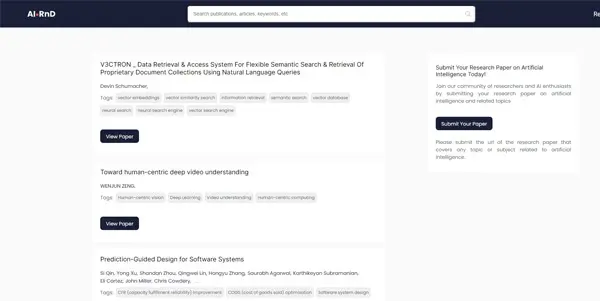AI-RnD

A centralized hub to access and share AI research articles. Support for collaboration between researchers
AI-RnD: A Centralized Hub for AI Research Collaboration
The accelerating pace of research in Artificial Intelligence (AI) necessitates efficient tools for knowledge sharing and collaborative work. AI-RnD emerges as a solution, providing a centralized platform to access and share AI research articles, fostering collaboration among researchers. This article delves into the functionalities, benefits, applications, and competitive landscape of this valuable free resource.
What AI-RnD Does
AI-RnD acts as a central repository for AI research articles, streamlining the process of accessing, sharing, and discussing relevant literature. It eliminates the need to navigate numerous disparate databases and websites, saving researchers valuable time and effort. The platform focuses on facilitating seamless collaboration, enabling researchers to connect, share insights, and work together on projects. It's designed to be user-friendly and intuitive, making it accessible to researchers of all levels of technical expertise.
Main Features and Benefits
AI-RnD offers several key features and benefits:
- Centralized Access to Research Articles: Researchers can access a wide range of AI research papers from a single platform, eliminating the need to search across multiple databases.
- Enhanced Collaboration: The platform facilitates collaboration through features that allow researchers to share articles, comment on them, and engage in discussions. This fosters a vibrant research community.
- Simplified Knowledge Sharing: Researchers can easily share their own work and findings with the wider community, accelerating the dissemination of knowledge.
- Improved Organization: Users can organize their research articles into custom collections, making it easier to manage and access relevant materials.
- Time Savings: By centralizing access to information and streamlining collaboration, AI-RnD significantly reduces the time researchers spend on administrative tasks, allowing them to focus on research.
Use Cases and Applications
AI-RnD is applicable across a wide range of AI research domains. Here are some key use cases:
- Academic Research: Students and professors can use AI-RnD to access relevant literature, collaborate on research projects, and stay up-to-date on the latest advancements in the field.
- Industry Research: AI researchers in industry can leverage the platform to share internal research findings, collaborate with external researchers, and track advancements relevant to their specific applications.
- Open Source Projects: Developers working on open-source AI projects can use AI-RnD to share code, documentation, and research findings, fostering a more collaborative and transparent development process.
Comparison to Similar Tools
While several other platforms offer resources for AI research, AI-RnD differentiates itself by focusing specifically on collaboration and providing a centralized, user-friendly experience. Other platforms may offer more specialized features (e.g., advanced data analysis tools) or focus on a narrower subset of AI research, whereas AI-RnD prioritizes accessibility and ease of use for a broader range of researchers. A direct comparison requires analyzing the specific features and capabilities of competing platforms on a case-by-case basis.
Pricing Information
AI-RnD is currently offered completely free of charge. This makes it accessible to researchers regardless of their funding or institutional affiliations.
Conclusion
AI-RnD provides a valuable contribution to the AI research community by offering a free, centralized hub for accessing and sharing research. Its emphasis on collaboration and user-friendly design makes it a powerful tool for accelerating the pace of AI innovation. The platform's continued development and expansion promise to further enhance its value to researchers worldwide.